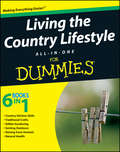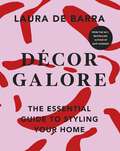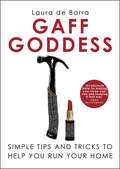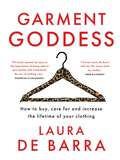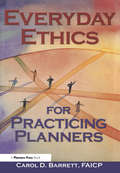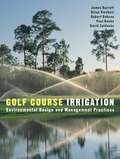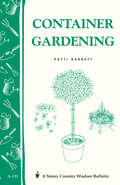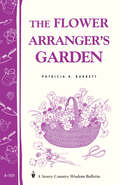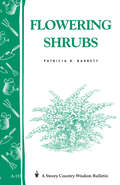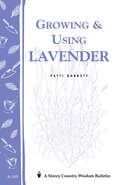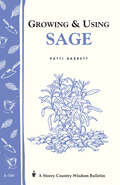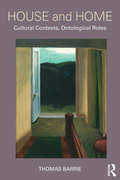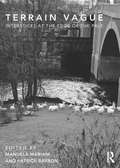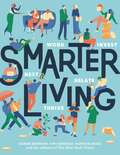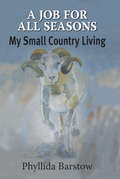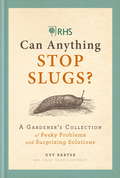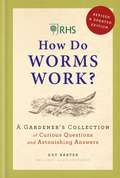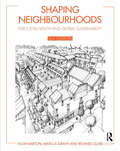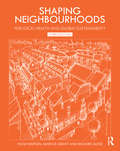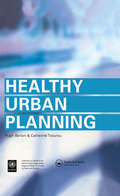- Table View
- List View
Living the Country Lifestyle All-In-One For Dummies
by Tracy L. BarrLiving the Country Lifestyle All-in-One For Dummies features six books in one, including: Country Cooking (cast-iron cooking, canning, pickling, and outdoor cooking, among other topics) Traditional Crafts (sheering animals and producing wool, knitting, hand sewing, patchwork and quilting, candle making) Kitchen Gardening (growing and caring for vegetables, herbs, and fruit) Outdoor Skills (camp skills, fishing, navigation, outdoor family fun) Raising Farm Animals (buying, housing, and raising animals, beekeeping) Natural Health (herbal remedies, an encyclopedia of herbs, and healing foods)
Décor Galore: The Essential Guide to Styling Your Home
by Laura de Barra*IBA LIFESTYLE BOOK OF THE YEAR*From the no. 1 Irish bestsellerCreative, stylish and incredibly practical, Laura will change how you view your space and open up a world of new possibilities.With Gaff Goddess Laura de Barra proved she was the queen of She-IY, but that was just the beginning. In Décor Galore she takes us room by room with genius and stunning tips for how to revamp your home on any budget. Whether you want to maximise storage, create layered lighting, or install a new kitchen, Décor Galore has got you covered.Gaff Goddess empowered you to pick up a drill and now Décor Galore will empower you to create the home you've always wanted.Praise for Laura de Barra: 'Genuinely, hands-on empowering!' Marian Keyes'An absolute bible for making your home your own' Emer McLysaght'I wish I'd found Laura de Barra twenty years ago!' Louise McSharry
Gaff Goddess: Simple Tips and Tricks to Help You Run Your Home
by Laura de Barra'(Gaff Goddess) should be taught in schools. It's genuinely, hands-on empowering! After four paragraphs I am fully convinced I could build my own house and go on Grand Designs!' - Marian KeyesLaura de Barra is quite simply a Gaff Goddess. Expanding on her popular online home hacks, Laura will teach you how to handle the problems we all encounter in our homes. Straight-talking and hilarious and packed with Laura’s stunning illustrations, her step-by-step guides will prepare you to handle the most common household emergencies with style. From dripping taps to hanging a frame, how best to look after your white goods, how to treat moths, mould and everything in between, and with invaluable design ideas to improve the living spaces in your home, this book is for everyone who has ever wanted to tackle a bit of She-IY without really knowing how.Ingenious and sure to be an instant household must-have, Gaff Goddess will empower you to make those repairs and rediscover your space saving you time, money and stress in the process.
Garment Goddess: How to buy, care for and increase the lifetime of your clothing
by Laura De BarraWould you like a long-lasting wardrobe filled with garments you love? New or vintage, online or high street – this book will help you buy right to begin with and maintain well for longevity, ensuring that your shopping, storage and laundry habits are enhancing and not hampering the life of your clothing. Delving into such delights as fabric composition and manufacturing techniques, as well as how to assess if garments are right for your wants and needs, Garment Goddess is a new bible for the modern home. In a world of fast fashion and dwindling quality, consumers have the power to influence what happens next. This book will not only help you to buy well, mend well and wear well, it will also help you to contribute positively to an industry impacted by overconsumption.
Everyday Ethics for Practicing Planners
by Carol Barrett"This book is on the suggested reading list for planners preparing to take the AICP exam. As veteran planner the author points out, the most troublesome conflicts for planners aren't between good and bad, they're between competing good, neither of which can be fully achieved. The 54 real-world scenarios described here typify the tough moral dilemmas that confront today's practioners. The author offers planners a way to recognize the ethical conflicts that arise in everyday practice, analyze them using ""practical moral reasoning,"" apply relevant sections of the AICP Code of Ethics and the APA/AICP Ethical Principles in Planning (both of which are included in full), and decide on the best course of action. The author tells a series of stories-each one a sticky situation that could confront a typical planner. Barrett points out the ethical issues, identifies possible alternatives, and cities relevant sections of the AICP Code. Finally, the author discusses the pros and cons of each alternative. Five particularly complex scenarios are especially intended for group discussion. Individuals studying for the AICP exam will find this book indispensable. But it also should be required reading for every planner who struggles to act ethically and for planning student who wants to understand how professionals define and serve the public interest. Planning agencies, private consulting firms, and planning commissions can use its realistic scenarios to jump start group discussions and workshops on ethical planning."
Everyday Ethics for Practicing Planners
by Carol Barrett"This book is on the suggested reading list for planners preparing to take the AICP exam. As veteran planner the author points out, the most troublesome conflicts for planners aren't between good and bad, they're between competing good, neither of which can be fully achieved. The 54 real-world scenarios described here typify the tough moral dilemmas that confront today's practioners. The author offers planners a way to recognize the ethical conflicts that arise in everyday practice, analyze them using ""practical moral reasoning,"" apply relevant sections of the AICP Code of Ethics and the APA/AICP Ethical Principles in Planning (both of which are included in full), and decide on the best course of action. The author tells a series of stories-each one a sticky situation that could confront a typical planner. Barrett points out the ethical issues, identifies possible alternatives, and cities relevant sections of the AICP Code. Finally, the author discusses the pros and cons of each alternative. Five particularly complex scenarios are especially intended for group discussion. Individuals studying for the AICP exam will find this book indispensable. But it also should be required reading for every planner who struggles to act ethically and for planning student who wants to understand how professionals define and serve the public interest. Planning agencies, private consulting firms, and planning commissions can use its realistic scenarios to jump start group discussions and workshops on ethical planning."
Golf Course Irrigation: Environmental Design and Management Practices
by James Barrett Brian Vinchesi Robert Dobson Paul Roche David ZoldoskeComplete guidelines to developing and maintaining the most effective, environment-friendly irrigation systems for golf courses Golf Course Irrigation offers valuable insight on the design, installation, management, and maintenance of irrigation systems-the most important management tool used on today's golf courses. Without manufacturers' bias, this useful resource provides hands-on guidance to the highest quality irrigation systems, including specifications and applications of the best pump stations, controllers, sprinkler heads, nozzles, valves, sensors, and other components that make the difference in top-quality irrigation systems. Typically regarded as significant users of water, golf courses are under increasing scrutiny by governmental and environmental groups, making it essential that the up-to-date information found here-on such topics as water supply, plant irrigation requirements, application uniformity, and construction management-be at the fingertips of every golf course professional. While fostering the best playing conditions, these systems conserve water and energy with such technology as low-pressure heads and controls that use "if/then" logic to automatically adjust to changing conditions, which can improve playability while saving money. Golf Course Irrigation is a practical tool to help golf course architects, builders, superintendents, irrigation consultants, designers, and installers to improve aesthetics and playing conditions in the face of diminishing natural resources. It is also an informative reference for golf course owners, developers, local officials, students, and fans of the game.
Container Gardening: Storey Country Wisdom Bulletin A-151 (Storey Country Wisdom Bulletin)
by Patricia R. BarrettSince 1973, Storey's Country Wisdom Bulletins have offered practical, hands-on instructions designed to help readers master dozens of country living skills quickly and easily. There are now more than 170 titles in this series, and their remarkable popularity reflects the common desire of country and city dwellers alike to cultivate personal independence in everyday life.
The Flower Arranger's Garden: Storey's Country Wisdom Bulletin A-103 (Storey Country Wisdom Bulletin)
by Patricia R. BarrettSince 1973, Storey's Country Wisdom Bulletins have offered practical, hands-on instructions designed to help readers master dozens of country living skills quickly and easily. There are now more than 170 titles in this series, and their remarkable popularity reflects the common desire of country and city dwellers alike to cultivate personal independence in everyday life.
Flowering Shrubs: Storey's Country Wisdom Bulletin A-132 (Storey Country Wisdom Bulletin)
by Patricia R. BarrettSince 1973, Storey's Country Wisdom Bulletins have offered practical, hands-on instructions designed to help readers master dozens of country living skills quickly and easily. There are now more than 170 titles in this series, and their remarkable popularity reflects the common desire of country and city dwellers alike to cultivate personal independence in everyday life.
Growing & Using Lavender: Storey's Country Wisdom Bulletin A-155 (Storey Country Wisdom Bulletin)
by Patricia R. BarrettSince 1973, Storey's Country Wisdom Bulletins have offered practical, hands-on instructions designed to help readers master dozens of country living skills quickly and easily. There are now more than 170 titles in this series, and their remarkable popularity reflects the common desire of country and city dwellers alike to cultivate personal independence in everyday life.
Growing & Using Sage: Storey's Country Wisdom Bulletin A-166 (Storey Country Wisdom Bulletin)
by Patricia R. BarrettSince 1973, Storey's Country Wisdom Bulletins have offered practical, hands-on instructions designed to help readers master dozens of country living skills quickly and easily. There are now more than 170 titles in this series, and their remarkable popularity reflects the common desire of country and city dwellers alike to cultivate personal independence in everyday life.
House and Home: Cultural Contexts, Ontological Roles
by Thomas BarrieHouse and home are words routinely used to describe where and how one lives. This book challenges predominant definitions and argues that domesticity fundamentally satisfies the human need to create and inhabit a defined place in the world. Consequently, house and home have performed numerous cultural and ontological roles, and have been assiduously represented in scripture, literature, art, and philosophy. This book presents how the search for home in an unpredictable world led people to create myths about the origins of architecture, houses for their gods, and house tombs for eternal life. Turning to more recent topics, it discusses how writers often used simple huts as a means to address the essentials of existence; modernist architects envisioned the capacity of house and home to improve society; and the suburban house was positioned as a superior setting for culture and family. Throughout the book, house and home are critically examined to illustrate the perennial role and capacity of architecture to articulate the human condition, position it more meaningfully in the world, and assist in our collective homecoming.
House and Home: Cultural Contexts, Ontological Roles
by Thomas BarrieHouse and home are words routinely used to describe where and how one lives. This book challenges predominant definitions and argues that domesticity fundamentally satisfies the human need to create and inhabit a defined place in the world. Consequently, house and home have performed numerous cultural and ontological roles, and have been assiduously represented in scripture, literature, art, and philosophy. This book presents how the search for home in an unpredictable world led people to create myths about the origins of architecture, houses for their gods, and house tombs for eternal life. Turning to more recent topics, it discusses how writers often used simple huts as a means to address the essentials of existence; modernist architects envisioned the capacity of house and home to improve society; and the suburban house was positioned as a superior setting for culture and family. Throughout the book, house and home are critically examined to illustrate the perennial role and capacity of architecture to articulate the human condition, position it more meaningfully in the world, and assist in our collective homecoming.
Terrain Vague: Interstices at the Edge of the Pale
by Patrick Barron Manuela MarianiAs planners and designers have turned their attentions to the blighted, vacant areas of the city, the concept of "terrain vague," has become increasingly important. Terrain Vague seeks to explore the ambiguous spaces of the city -- the places that exist outside the cultural, social, and economic circuits of urban life. From vacant lots and railroad tracks, to more diverse interstitial spaces, this collection of original essays and cases presents innovative ways of looking at marginal urban space, with studies from the United States, Europe and the Middle East, from a diverse group of planners, geographers, and urban designers. Terrain Vague is a cooperative effort to redefine these marginal spaces as a central concept for urban planning and design. Presenting innovative ways of looking at marginal urban space, and focusing on its positive uses and aspects, the book will be of interest to all those wishing to understand our increasingly complex everyday surroundings, from planners, cultural theorists, and academics, to designers and architects.
Smarter Living: Work - Nest - Invest - Relate - Thrive
by Karen Barrow Tim Herrera Karron SkogSmart, actionable advice and life tips on how to improve your career, your home, your finances, your relationships, and your health for a happier life -- all from the popular Smarter Living section of the New York Times.Launched in the summer of 2016, the New York Times Smarter Living section was created with the mission to help readers live better lives by publishing stories that have fallen between the news desks. Since then, the section has produced more than 250 pieces offering useful advice on a wide range of topics -- including career and finance, love and relationships, health and wellness, and more -- that have been read by more than 22 million unique readers. Smarter Living collects these very popular pieces into one handy guide, creating a trusted source that will appeal to those just starting out as well those looking for new approaches to life's problems. The book identifies 5 key areas for building a better life: Work, Nest, Invest, Relate, and Thrive. Each area contains advice curated from the column on topics such as the Art of the Out of Office Reply, the Annual Home Checklist, What to Do When You're Bad at Money, How to Maintain Friendships, and How to Be Better About Stress. Each entry breaks down these sometimes overwhelming topics into manageable tasks through clear and concise guidance, easy-to-follow lists, and informative sidebars. Thoughtfully designed with bright, four-color illustrations similar to those found in the section, Smarter Living will be a perennial reference on how to create a healthy and happy life.
Smarter Living: Work - Nest - Invest - Relate - Thrive
by Karen Barrow Tim Herrera Karron SkogSmart, actionable advice and life tips on how to improve your career, your home, your finances, your relationships, and your health for a happier life -- all from the popular Smarter Living section of the New York Times.Launched in the summer of 2016, the New York Times Smarter Living section was created with the mission to help readers live better lives by publishing stories that have fallen between the news desks. Since then, the section has produced more than 250 pieces offering useful advice on a wide range of topics -- including career and finance, love and relationships, health and wellness, and more -- that have been read by more than 22 million unique readers. Smarter Living collects these very popular pieces into one handy guide, creating a trusted source that will appeal to those just starting out as well those looking for new approaches to life's problems. The book identifies 5 key areas for building a better life: Work, Nest, Invest, Relate, and Thrive. Each area contains advice curated from the column on topics such as the Art of the Out of Office Reply, the Annual Home Checklist, What to Do When You're Bad at Money, How to Maintain Friendships, and How to Be Better About Stress. Each entry breaks down these sometimes overwhelming topics into manageable tasks through clear and concise guidance, easy-to-follow lists, and informative sidebars. Thoughtfully designed with bright, four-color illustrations similar to those found in the section, Smarter Living will be a perennial reference on how to create a healthy and happy life.
A Job for All Seasons: My Small Country Living
by Phyllida BarstowMany smallholders have plunged in at the deep end and learnt the hard way, through experience. But Phyllida Barstow, author of the childhood autobiography My Animals and Other Family, was already involved in animal husbandry when, as a young woman, she embarked on her own smallholding enterprise. Here is her lively, informative and witty account of her first-hand experience throughout her lifetime in Gloucestershire, with chickens, dogs, cats, horses, sheep, peacocks, alpacas and even honey bees. As she points out, smallholding is not a summer idyll but, truly, a job for all seasons, all hours, all weathers. She also has to deal with fallen stock, pest control, disease outbreaks and slaughter. Her tips include those on animal handling, training, breeding and delivery. Her wry and practical attitude towards her animals is imbued with respect and often affection for her charges. This account of the realities of modern smallholding is both entertaining and informative.
RHS Can Anything Stop Slugs?: A Gardener’s Collection of Pesky Problems and Surprising Solutions
by Guy BarterRHS Can Anything Stop Slugs assists with all of the most common problems encountered in a garden - as well as some slightly more unusual ones. The RHS's Chief Horticulturist, Guy Barter, provides expert advice, responding to the questions posed by thousands of gardeners every year.This entertaining and informative guide provides a wealth of information. Feature boxes of interesting facts enable you to really get to grips with the issue at hand.As the cause of a problem is not always apparent, the main symptom is used as the starting point in each section, enabling you to troubleshoot all your garden problems. This is not a dull reference book full of lists - it is an easy-to-read and amusing look at how we battle with nature in our gardens, showing you how to either come out top or to surrender with dignity.
RHS How Do Worms Work?: A Gardener's Collection of Curious Questions and Astonishing Answers
by Guy Barter The Royal Horticultural Society'This is a lovely book to dip into, and you may even find yourself reading it cover to cover' - the Guardian'An enlightening and entertaining read that will leave the reader armed with the facts and insight to improve their garden as well as their general knowledge' - The English GardenRHS How Do Worms Work? provides expert answers to the questions that every gardener wants to ask - and a few that you never even dreamt of. As well as answering the titular question about soil's best friend, this fact-filled journey through the world of the garden is packed with Q&As that are sometimes practical, sometimes whimsical and always intriguing. This richly illustrated volume is an absorbing guide to the quirky and lesser-known aspects of gardening and a perfect gift for any gardener with an inquisitive mind.With sections on Seeds and Plants; Flowers and Fruits; Below the Ground; Weather, Climate and the Seasons; and In the Garden, RHS How Do Worms Work? holds the answers to common questions such as:- What's the difference between a fruit and a vegetable?- Is it true that sunflower heads follow the sun?- When is a plant a weed?- How do you attract butterflies?- How long can a plant survive without water?and many more.
Shaping Neighbourhoods: For Local Health and Global Sustainability
by Hugh Barton Marcus Grant Richard GuiseThis substantially revised and important second edition comes at a pivotal time, with both a strong agenda of localism in planning and with public health professionals now realising the vital importance of shaping urban environments in order to reduce the burden of disease and support better health outcomes. This guide ensures you: understand the underlying principles for planning healthy and sustainable neighbourhoods and towns plan the collaborative and inclusive processes needed for multi-sectoral cooperation develop know-how and skills in matching local need with urban form discover new ways to integrate development with natural systems design places with character and recognise good urban form guide communities, and advise developers, in the creation of successful and sustainable places for living. Containing many new case studies and a wealth of new research, this new edition has benefited from previous user feedback. Shaping Neighbourhoods is the indispensable guide for bridging the gulf between theory and practice, between planning authorities, investors and communities, and between different professional perspectives. Whether you are a student faced with a local planning project; a planner, urban designer or developer involved in new development; a health authority concerned with promoting physical activity; or a community group wanting to improve your neighbourhood; this book is for you.
Shaping Neighbourhoods: For Local Health and Global Sustainability
by Hugh Barton Marcus Grant Richard GuiseThis substantially revised and important second edition comes at a pivotal time, with both a strong agenda of localism in planning and with public health professionals now realising the vital importance of shaping urban environments in order to reduce the burden of disease and support better health outcomes. This guide ensures you: understand the underlying principles for planning healthy and sustainable neighbourhoods and towns plan the collaborative and inclusive processes needed for multi-sectoral cooperation develop know-how and skills in matching local need with urban form discover new ways to integrate development with natural systems design places with character and recognise good urban form guide communities, and advise developers, in the creation of successful and sustainable places for living. Containing many new case studies and a wealth of new research, this new edition has benefited from previous user feedback. Shaping Neighbourhoods is the indispensable guide for bridging the gulf between theory and practice, between planning authorities, investors and communities, and between different professional perspectives. Whether you are a student faced with a local planning project; a planner, urban designer or developer involved in new development; a health authority concerned with promoting physical activity; or a community group wanting to improve your neighbourhood; this book is for you.
Shaping Neighbourhoods: For Local Health and Global Sustainability
by Hugh Barton Marcus Grant Richard GuiseShaping Neighbourhoods is unique in combining all aspects of the spatial planning of neighbourhoods and towns whilst emphasising positive outcomes for people’s health and global sustainability. This new edition retains the combination of radicalism, evidence-based advice and pragmatism that made earlier editions so popular. This updated edition strengthens guidance in relation to climate change and biodiversity, tackling crises of population health that are pushing up health-care budgets, but have elements of their origins in poor place spatial planning – such as isolation, lack of everyday physical activity, and respiratory problems. It is underpinned by new research into how people use their localities, and the best way to achieve inclusive, healthy, low-carbon settlements. The guide can assist with: • Understanding the principles for planning healthy and sustainable neighbourhoods and towns • Planning collaborative and inclusive processes for multi-sectoral working • Developing know-how and skills in matching local need with urban form • Discovering new ways to integrate development with natural systems • Designing places with character and recognising good urban form Whether you are a student faced with a local planning project; a public health professional, planner, urban designer or developer involved in new development or regeneration; a council concerned with promoting healthy and sustainable environments; or a community group wanting to improve your neighbourhood – you will find help here.
Shaping Neighbourhoods: For Local Health and Global Sustainability
by Hugh Barton Marcus Grant Richard GuiseShaping Neighbourhoods is unique in combining all aspects of the spatial planning of neighbourhoods and towns whilst emphasising positive outcomes for people’s health and global sustainability. This new edition retains the combination of radicalism, evidence-based advice and pragmatism that made earlier editions so popular. This updated edition strengthens guidance in relation to climate change and biodiversity, tackling crises of population health that are pushing up health-care budgets, but have elements of their origins in poor place spatial planning – such as isolation, lack of everyday physical activity, and respiratory problems. It is underpinned by new research into how people use their localities, and the best way to achieve inclusive, healthy, low-carbon settlements. The guide can assist with: • Understanding the principles for planning healthy and sustainable neighbourhoods and towns • Planning collaborative and inclusive processes for multi-sectoral working • Developing know-how and skills in matching local need with urban form • Discovering new ways to integrate development with natural systems • Designing places with character and recognising good urban form Whether you are a student faced with a local planning project; a public health professional, planner, urban designer or developer involved in new development or regeneration; a council concerned with promoting healthy and sustainable environments; or a community group wanting to improve your neighbourhood – you will find help here.
Healthy Urban Planning
by Hugh Barton Catherine TsourouHealthy Urban Planning aims to refocus urban planners on the implications of their work for human health and well-being. If many of the problems faced in cities are to be resolved, improving health will be the fundamental goal of urban planners. Poor housing, poverty, stress, pollution, and lack of access to jobs, goods and services all impact upon health. This book provides practical advice on ways to integrate health and urban planning and will be essential reading for urban planners, developers, urban designers, transport planners, and those working in the fields of regeneration and renewal. It will also be of interest to those with an interest in sustainable development.
